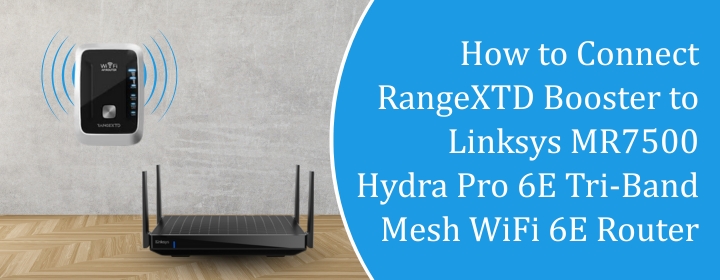
How to Connect RangeXTD Booster to Linksys MR7500 Hydra Pro 6E Tri-Band Mesh WiFi 6E Router
Linksys MR7500 Hydra Pro 6E router, was working well, but suddenly, the signal started fainting in the upper bedroom. Also, in the basement? Do not worry if you’re in the same circumstance. This is a common issue among the users.
That’s when a booster like the RangeXTD WiFi Booster comes in use. It’s not magic, but if you position and set it up properly, it fills up those dead spots with continuous internet connectivity. Let’s learn how to perform rangextd set up with the easy-to-follow methods.
Find the Right Place to Plug It In
Placement of the device matters a lot. Avoid placing the device in the back of your home where the Wi-Fi is not able to receive signals from the router.
Choose a midway ground. A place that is in the middle of the router and low network area. If your primary router is downstairs, an outlet in the corridor near the stairs could work. You want the booster to get a strong enough signal so it can send it further without getting stuck.
Put it in. Take a minute. The LED will start to blink.
1. Link your device to the booster
Now, turn on your laptop or phone. Go to Wi-Fi settings. Something like “RangeXTD” will come up. Tap to connect. You don’t need a password for the initial rangextd setup.
Your browser may not open automatically, so enter rangextd login or the device label’s IP address (192.168.7.234). This takes you to the setup page. Though simple, don’t ignore it. Incorrect URLs result in “page not found.”
2. Log in and start Rangextd setup.
The login is generally something simple, like “admin.” Once you’re in, the booster will discover the network on its own.
Now, you should be able to find your Linksys MR7500 on that list. Choose it. Carefully type in your primary Wi-Fi password. Look at each letter. We’ve seen a lot of individuals type quickly and then wonder why the booster won’t work.
This is the stage when the booster picks up the signal from your router.
3. Select the network name.
The booster will ask whether you want to maintain or change your Wi-Fi name.
With the same name and password, it appears as one Wi-Fi. Your gadgets move between the router and booster without even thinking about it. But if you want to be in charge, like knowing precisely when you’re on the booster, call it something like “MyWiFi_EXT.”
4. Let the devices connect
The router and the booster are practically connected in the backend. Don’t plug out anything, just move the device a bit closer during the rangextd login. Let the lights calm down. If the LED has turned out solid green or blue, it indicates the devices have begun to transmit the signals.
5. Check the connection where it really counts
After it’s connected, go out of rangextd setup mode. Unplug your phone from the booster network and plug it back into your Wi-Fi.
Now get up and stroll around. Go to that one irritating place where the signal used to be bad. If you put it up correctly, you should see strong bars presently. Not mind-blowing speed, but consistent and useful. That’s what we want to do.
6. Move things around if you need to.
People frequently forget about this portion. A little change, like relocating the booster one wall closer to the router, may make a big effect.
It’s not about making guesses. Finding that perfect spot is important because the booster has to be close enough to get a good signal yet far enough away to push coverage out. We really do this trial-and-error thing when we install things. Don’t expect to get it right the first time.
7. Make sure the Booster Settings are safe
Once you’re comfortable with the coverage, go back to rangextd login. Change the password for the admin account. Do this, really. If you leave it at “admin,” it’s like leaving your front door open.
You may change other little things, but don’t go too elaborate if it’s functioning. Just lock it up and leave it alone.
8. Look at the settings on your Linksys router
The Linksys MR7500 Hydra Pro 6E router is excellent. But for additional security, MAC filtering and disguised SSIDs may need to be turned off for a while so the booster can join.
You may tighten those settings again when the booster is connected. It’s simply a normal aspect of the handshake. Some routers are pickier than others.
Little Problems We Often See
- The booster doesn’t show up in the list of Wi-Fi networks. Put it back to factory settings.
- Can’t open the rangextd setup page: Type the IP address directly.
- The signal keeps dropping. Move it closer.
- Devices jumping back and forth between the router and the booster: Use the same SSID.
Most issues aren’t that hard to figure out. It’s generally only one little item that’s wrong.
Last Thought
Hope you understand, setting up the RangeXTD isn’t that hard. But it does take some time and the appropriate sequence of actions. First, reset the device, find a suitable place to sit, log in correctly, and don’t freak out when the lights flicker for a minute.
Your coverage becomes a lot better after it’s connected to the Linksys MR7500. No more empty corners. No more browsing in the hallway. Just good, reliable Wi-Fi throughout the home.
We’ve put this up for clients dozens of times. It’s not always great the first time, but if you get it right, it simply works.
That’s pretty much the entire concept. Easy. Trustworthy. Done correctly.